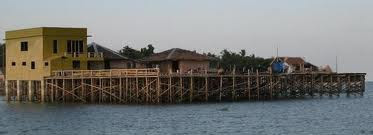SEAWEEDS FARMING

Seaweed
is a primitive sea plant belonging to the algae family with origins
dating back millions of years. It comes in four popular varieties
(scientifically known as: cottonii, agar-agar, spinosum and eucheuma).
It is an important food in many Asian cultures. Japanese cuisine employs
different varieties (such as kombu, laver and nori) for many uses
including soups, vegetables, tea, sushi and as general seasoning. It is
also a rich source of iodine, an important nutrient. Many seaweeds also
provide alginic acid, a jellylike substance that's used as a stabilizer
and thickener in a wide variety of commercially processed foods such as
ice creams, puddings, flavored milk drinks, pie fillings, soups and
syrups.
This seaweed phenomenon has dramatically elevated their lives
economically in total contrast with what they used to do and have in
fishing. Every able family member of any household in the community are
either directly or indirectly involved in the overall cycle in the
cultivation of the product, of course with monetary considerations as to
labour being invested from its preparation prior to planting, to
harvesting and drying for final delivery to the buyers. Consequently,
the limited earning capacity of the people on fishing had been
satisfactorily augmented and practically made easy and tenable by the
advent of this industry.

Hingotanan and Dawahon share about 35% of the country's total production. The most common variety being cultivated here are Cottonii (Kappaphycus alvarezii) and Spinosum (eucheuma denticulatum) which together provide about three quarters of the world production. They grow at sea level down to about 2 metres. Seaweed is normally grown on nylon lines strung between bamboo floats and harvested after three months or so when each plant weighs around 1 kilogram. The shallow waters along the Dawahon Reef was found to be perfectly suitable in the cultivation and farming of this marine plant commercially.
After harvest, the seaweed is dried, baled and sent to the carrageenan
manufacturer. There the seaweed is ground, sifted to remove impurities
such as sand and washed thoroughly. After treatment with hot alkali
solution (e.g. 5-8% potassium hydroxide), the cellulose is removed from
the carrageenan by centrifugation and filtration. The resulting
carrageenan solution is then concentrated by evaporation. It is dried
and ground to specifications.
On top of these God given bounties, the island is also blessed with
intellectual abundance in reference to its numerous professionals who
are mostly successful in their individual fields of endeavor locally and
abroad. Some are in high places in the government, numerous managers in
different private companies and many are successful private
practitioners in the field of law, medicine, engineering and
entrepreneurship.
Drying of Seaweeds
Drying of Seaweeds

Harvesting Seaweeds
Platforms (where seaweeds are dried)
Platforms
are small warehouses that are build in seas where seaweeds are dried
and stocked. People mostly ,build their own for their survival and
others are for the sucess of business purposes.
A VIDEO(How this occupation helps people)
People in Hingotanan have a common way of finding a living for their
existence and survival. They are engaged with the occupation that is
termed SEAWEEDS FARMING. The
place is naturally abundant of marine products called SEAWEED (with
varieties like: agar-agar, eucheuma, cottonii and spinosum and when
processed will have a by-product called, Carrageenan)It was
scientifically found to be an excellent stabilizer for toothpaste
making; thickener for fire fighting foam, shampoo and cosmetic creams;
gel for shoe polish, ice cream, milk shakes, sweetened condensed milk
and sauces and many more. It is an important food in many Asian cultures and that is one of the main reasons why it is demand from other countries.
It is also a rich source of iodine, an important nutrient. Many
seaweeds also provide alginic acid, a jellylike substance that's used as
a stabilizer and thickener in a wide variety of commercially processed
foods such as ice creams, puddings, flavored milk drinks, pie fillings,
soups and syrups.















No comments:
Post a Comment